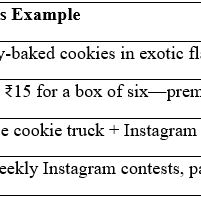Mastering the 4 Ps: The Marketing Mix Made Easy for Beginners
Want to know the secret behind successful brands like Nike, Apple, or even your favorite cookie shop? It’s the Marketing Mix—aka the 4 Ps of Marketing: Product, Price, Place, and Promotion. In this beginner-friendly, fun-to-read guide, we’ll break down each P with real-life examples, smart tips, and common mistakes to avoid (with zero jargon). Whether you’re building a business or just curious about how marketing actually works, this article will make you smarter, savvier, and maybe even a little hungry.
MARKETING DECODED
ThinkIfWeThink
4/9/20258 min read


Marketing Mix (The 4 Ps): The Secret Recipe Behind Every Successful Product
Introduction: What You’ll Discover Here
Before we get into the good stuff, here’s what this article is really about:
The 4 Ps of marketing—Product, Price, Place, and Promotion—are like the ingredients in your favorite recipe. Get the mix right, and you’ve got a hit on your hands. Mess one up, and you’ve got burnt toast (or in marketing terms, a failed product launch).
Whether you’re starting a small business, launching an app, or just curious about how brands win customers, this guide will break down each component of the Marketing Mix using simple language, real-life examples, and even some cookie talk.
So grab a snack and let’s decode the secret sauce of marketing.
What Is the “Marketing Mix”?
Imagine you’re making a sandwich. You’ve got the bread, fillings, condiments, and your sandwich-making skills. If any of those is off (soggy bread, too much mayo), your sandwich flops.
Marketing works the same way.
The Marketing Mix is the strategic combination of four key elements—called the 4 Ps—that businesses use to bring a product or service to market and convince people to buy it.
Think of it as your marketing recipe card:
What are you offering?
At what price?
Where will people find it?
And how will they hear about it?
The concept was first introduced by James Culliton and made famous by E. Jerome McCarthy in 1960, who coined the 4 Ps framework. It has been the go-to tool for marketers ever since.
Why Should You Care About the 4 Ps?
Whether you’re a business owner, student, or curious consumer, knowing the 4 Ps can help you:
Make smarter buying and selling decisions
Understand why certain brands catch your eye
Sound brilliant at parties when someone mentions marketing
Start your own business without feeling lost
Let’s now dive deep into each of the 4 Ps—keeping it fun and practical.
1. Product – “What the Heck Are You Selling?”
This one’s obvious. Your product is the actual item or service you’re offering. But it’s much more than just the thing itself—it includes all the elements that make it valuable and appealing.
It’s Not Just “Cookies”—It’s an Experience
Let’s say you’re selling cookies. Your product includes:
The flavor (Chocolate chip? Spicy chili dark chocolate?)
The quality (Fresh-baked, preservative-free, grandma’s recipe)
The features (Gluten-free? Extra gooey?)
The packaging (Eco-friendly, colorful, gift-ready)
The emotional benefit (Comfort food? Impressing your crush?)
Real-World Example: Apple iPhone
Apple didn’t just launch a phone. They offered:
A camera, music player, web browser, and GPS—all in one
A sleek design that screams premium
A brand ecosystem that keeps users loyal
They solved a real problem (carrying multiple gadgets is annoying), then wrapped the solution in an irresistible package.
2. Price – “Show Me the Money”
Price is what your customer pays. But it’s also a message. It tells people whether your product is a luxury, a steal, or somewhere in between.
Pricing is Psychology
Back to our cookie business:
₹1 per cookie? People may assume it’s low-quality
₹10 per cookie? Too expensive unless it’s gold-plated
₹3 per cookie? Premium but affordable—sounds about right
Your price depends on:
What customers are willing to pay
Competitor pricing
Your costs and desired profit
How you want your product to be perceived
Real-World Example: Rolex vs. Casio
Both show the time accurately.
But Rolex says luxury, exclusivity, and success—while Casio says affordability and practicality. That’s perceived value, and price plays a huge role in it.
3. Place – “Where Can I Get This Amazing Thing?”
Place is all about where and how people can buy your product. It’s not just about geography—it’s also about convenience, timing, and the channels you use.
Cookies on Wheels?
Let’s say your cookie biz uses a mobile food truck that:
Visits corporate offices at lunchtime
Parks near gyms in the evening (because… balance)
Also takes online orders via Instagram DMs
That’s Place strategy in action.
Real-World Example: Amazon
Amazon’s success is built on place. It didn’t invent products—it made them easier to buy. Their genius is in reducing buying friction with fast delivery, one-click purchasing, and massive availability.
4. Promotion – “Hey! Look Over Here!”
Promotion is how you get the word out. It includes:
Advertising
Social media
Email campaigns
Discounts and special offers
Word of mouth
PR stunts
Make Noise… With Purpose
If no one knows about your cookies, they won’t sell—no matter how tasty they are.
Promotion ideas:
Free mini-cookie samples at college fests
“Cookie of the Week” Instagram reels
Buy-one-get-one-free coupons at coworking spaces
A witty signboard: “Cookies > Deadlines”
Real-World Example: Zomato
Zomato promotes through humor, trending topics, and relatability. Their brand voice is so strong that people follow them even if they’re not hungry.
Promotion isn’t just yelling “Buy Now!”—it’s about telling your story in a way that connects.
Bringing It All Together – The Cookie Business Case
Let’s wrap up the 4 Ps with a complete cookie example:
Each P supports the others. Miss one, and the mix falls apart.
Imagine the cookies taste great, but the truck never shows up, or you priced them ₹15 each—disaster!
A Real Case Study: Nike’s Marketing Mix
Nike is a masterclass in the 4 Ps:
Product: Not just shoes. Innovation, performance, and style. Air Max, Flyknit, self-lacing shoes—it’s all about offering more than just footwear.
Price: Premium pricing reflects brand quality. Limited editions create hype and exclusivity.
Place: Nike sells through flagship stores, online platforms, retail partners, and its own app.
Promotion: Powerful storytelling (“Just Do It”), athlete endorsements, and emotional campaigns that go beyond selling gear—they sell ambition and empowerment.
That’s the 4 Ps working together to build a billion-dollar brand.
Is the Marketing Mix Still Relevant?
Yes—more than ever. The world has changed, and so have marketing channels. But the 4 Ps still form the core of every great marketing strategy.
In service-based industries (like consulting or fitness), people often expand the mix to include:
People – Your team, customer service, brand ambassadors
Process – How services are delivered
Physical Evidence – Store ambiance, reviews, packaging
But even in the digital age, the original 4 Ps are your starting point.
Final Takeaway: Mix It Like a Pro
The Marketing Mix isn’t rocket science—it’s common sense structured into a usable plan. Whether you’re selling cookies or coding the next unicorn startup, remember:
Product – Solve a real problem
Price – Match the value you offer
Place – Be where your customers are
Promotion – Tell your story loud, clear, and creatively
So next time you buy a cup of coffee or download a new app, try spotting the 4 Ps.
You’ll realize you’ve been surrounded by marketing strategies all along.
And who knows?
You might just become a marketing genius without ever opening a textbook.
Common Mistakes Businesses Make with the 4 Ps
(And How to Avoid a Marketing Faceplant)
The 4 Ps of Marketing sound simple enough, right?
Product. Price. Place. Promotion.
Easy as pie.
(Unless you’re selling pie. Then it’s a little more complicated.)
But here’s the catch: many businesses mess them up, sometimes in the most facepalm-worthy ways.
Let’s look at the most common mistakes people make with the 4 Ps—so you can avoid them like a marketing pothole.
1. P for Product: Selling Something Nobody Wants
Mistake:
Creating a product that YOU love… but no one else asked for.
(Spoiler alert: your mom saying it’s “amazing” doesn’t count as market research.)
Example:
You open a café that only sells durian-flavored cupcakes. Sure, you’re passionate. But if most people in your city hate the smell of durian, you’ve got a problem. Not a product.
Why it fails:
Great marketing can’t save a product that nobody wants. The most common mistake here is ignoring customer needs and building something based on assumptions.
How to avoid it:
Test your idea with real people
Ask for feedback (and actually listen)
Focus on solving a real problem, not just creating a “cool” thing
2. P for Price: Playing Pin-the-Tail-on-the-Pricetag
Mistake:
Setting a price based on gut feeling, wishful thinking, or… vibes.
Two classic fails:
Pricing it too high (and scaring people away)
Pricing it too low (and people thinking it’s sketchy or low-quality)
Example:
You sell handmade soap bars for ₹500 each. They’re nice, but unless they also do your taxes, people will likely move on.
Or, you price them at ₹20 and can’t even cover your costs. Oops.
Why it fails:
Price isn’t just math—it’s psychology. People associate price with quality, status, and value.
How to avoid it:
Study what competitors are charging
Understand your target customer’s budget
Consider what the price says about your brand
3. P for Place: Being Hard to Find (a.k.a. Marketing Hide-and-Seek)
Mistake:
Launching your product… and then forgetting to tell people where to get it. Or worse, making it difficult to access.
Example:
You start a clothing brand but only sell it through a clunky website that crashes half the time and has no payment options. Or you open a store that’s beautifully designed—on a hilltop where no one lives.
Why it fails:
Even the best product will flop if people can’t find it, or if the buying process feels like an obstacle course.
How to avoid it:
Be where your audience already is (online, offline, or both)
Make the buying process smooth and obvious
Don’t make people work to give you their money
Bonus tip: Always test your checkout process. If your grandma can’t place an order, fix it.
4. P for Promotion: Shouting into the Void (or Saying the Wrong Thing)
Mistake:
Either promoting too little… or promoting the wrong way. Some brands just whisper into the wind, while others scream in all directions without any real message.
Example 1 – Too quiet:
You launch a beautiful product… and your only promotion is one cryptic Facebook post. No one sees it. Crickets.
Example 2 – Too chaotic:
You spam your audience with 12 “BUY NOW!!!” messages in one day. People block you. Or report you. Or both.
Why it fails:
Promotion isn’t just about talking—it’s about connecting. Poor promotion means wasted effort or annoying people.
How to avoid it:
Know your target audience and speak their language
Choose the right platforms (Instagram? Email? Street posters?)
Focus on storytelling, not just selling
Be consistent, not spammy
Bonus Mistake: Treating the 4 Ps Like a To-Do List Instead of a Strategy
Some businesses treat the 4 Ps like a form they fill out once and forget. But markets change, people change, trends change—and your strategy should too.
Common signs you’re doing this:
You never update your pricing, even when costs go up
You never ask if your product still solves a relevant problem
You keep promoting the same way, even if engagement drops
How to avoid it:
Review your 4 Ps regularly (monthly or quarterly)
Ask your customers for feedback
Be willing to tweak things—adaptability is key
Final Thought: The 4 Ps Aren’t Magical—They’re Intentional
The most successful businesses don’t “luck into” great marketing.
They think through the 4 Ps carefully—and keep adjusting based on results.
So, avoid the classic mistakes:
Don’t sell something no one wants
Don’t price it based on what your gut says after lunch
Don’t make people climb a mountain to buy your stuff
And definitely don’t scream into the marketing void
Get your mix right, and you’ve got a recipe for something customers will actually want—and come back for.
Key Takeaways from the Marketing Mix (4 Ps) Article
The Marketing Mix is like a recipe
It combines four essential ingredients—Product, Price, Place, and Promotion—that every business needs to bring a product or service to market effectively.Each “P” plays a critical role
Product: It's not just what you're selling, but the value, quality, features, packaging, and emotional connection it offers.
Price: More than numbers—it reflects your product’s value and influences how people perceive it.
Place: Where and how your product is sold directly affects accessibility and convenience.
Promotion: It’s how you tell your story and create awareness—through ads, social media, discounts, or even free samples.
A good product alone isn’t enough
You need a balanced mix—poor promotion or bad pricing can sink even the best product.Real-world examples make the 4 Ps come alive
Brands like Apple, Nike, Amazon, and Zomato show how aligning all 4 Ps creates powerful and lasting customer impact.The 4 Ps apply to small businesses too
Even a cookie business or soap seller can (and should) think strategically about each P to stand out.There are common (and avoidable) mistakes
Selling something no one asked for
Random or extreme pricing
Poor accessibility (Place)
Over-promotion or no promotion at all
The 4 Ps are not a one-time checklist
They should evolve with your market, customers, and business goals. Regularly revisit and adjust your mix.Marketing isn’t magic—it’s intentional strategy
When used thoughtfully, the 4 Ps help you create a brand people love, trust, and keep coming back to.


Subscribe to our newsletter
Enjoy exclusive special deals available only to our subscribers.
Learn
Explore topics made easy for everyone here.
Share
© 2025. All rights reserved.
